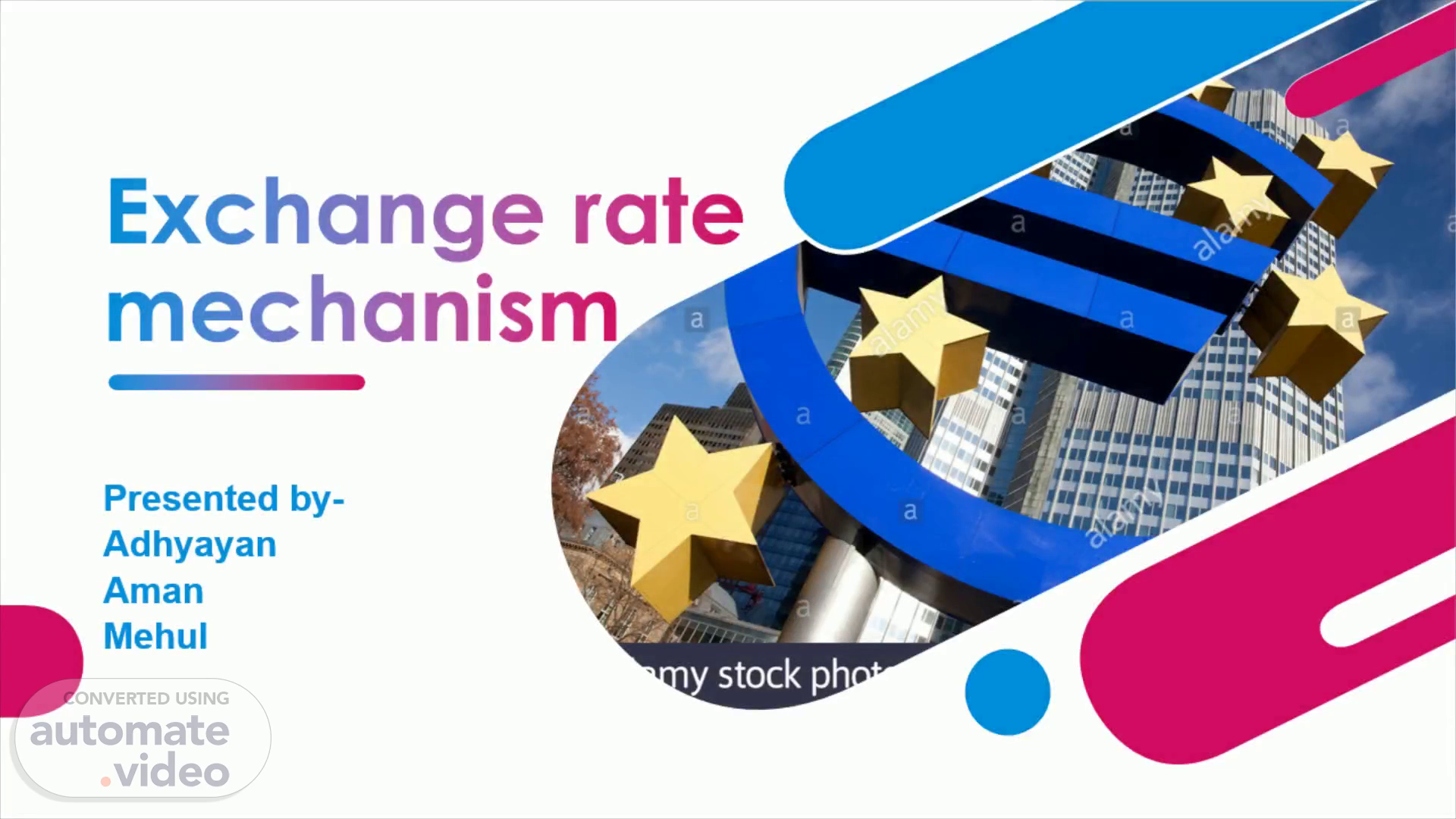
Exchange rate mechanism
Scene 1 (0s)
Good morning to one and all present here today I Adhyayan along with my team members Aman and mehul are going to discuss about the topic Exchange rate mechanism. So let us begin.
Scene 2 (7s)
An exchange rate mechanism (ERM) is a set of procedures used to manage a country's currency exchange rate relative to other currencies. It is part of an economy's monetary policy and is put to use by central banks. Such a mechanism can be employed if a country utilizes either a fixed exchange rate or one with a constrained floating exchange rate that is bounded around its peg (known as an adjustable peg or crawling peg). Monetary policy is the process of drafting, announcing, and implementing the plan of actions taken by the central bank, currency board, or other competent monetary authority of a country that controls the quantity of money in an economy and the channels by which new money is supplied. Under a currency board, the management of the exchange rate and money supply is given to a monetary authority that makes decisions about the valuation of a nation’s currency. Often, this monetary authority has direct instructions to back all units of domestic currency in circulation with foreign currency..
Scene 3 (48s)
How ERMs Work. Actively managed ERMs work by setting a reasonable trading range for a currency's exchange rate..
Scene 4 (1m 25s)
ERMs in Practice. The most popular example of an ERM is the European Exchange Rate Mechanism..
Scene 5 (2m 5s)
Different Types of Exchange Rate Mechanisms. 5. The Float The Fixed Rate The Pegged Float.
Scene 6 (2m 14s)
6. The Float Exchange Rate. A floating exchange rate is a regime where the currency price of a nation is set by the forex market based on supply and demand relative to other currencies. This is in contrast to a fixed exchange rate, in which the government entirely or predominantly determines the rate. A floating exchange rate is one that is determined by supply and demand on the open market. Floating exchange rates became more popular after the failure of the gold standard and the Bretton Woods agreement..
Scene 7 (2m 38s)
7. The Fixed Exchange Rate. A fixed exchange rate is a type of exchange rate regime where a currency is fixed against the value of another currency, basket of other currencies, or gold. There are several benefits and drawbacks of a fixed exchange rate. One major benefit is that a typical fixed exchange rate does not change based on market conditions. This allows for improved international trade and investments. The fixed exchange rate system can be used to control the behavior of currency by limiting inflation..
Scene 8 (3m 1s)
8. The Pegged Float. An adjustable peg rate floats on the market and changes with respect to economic conditions. Generally, the central bank will set a degree of flexibility anchored against a specific level or peg. It is then the central bank’s responsibility to ensure that the target exchange rate remains at the peg. The peg rate is most notably used by the Chinese, who peg the Chinese yuan to the U.S. dollar. China uses the peg rate to make its exports more attractive to international buyers relative to other countries supplying the same goods..
Scene 9 (3m 38s)
BIG IMAGE. EXCHANGE RATE MECHANISM. 9.
Scene 10 (3m 45s)
10. The most notable exchange rate mechanism occurred in Europe during the late 1970s. The European Economic Community introduced the ERM in 1979, as part of the European Monetary System (EMS), to reduce exchange rate variability and achieve stability before member countries moved to a single currency. It was designed to normalize exchange rates between countries before they were integrated in order to avoid any problems with price discovery. On September 16, 1992, a day known as Black Wednesday, a collapse in the pound sterling forced Britain to withdraw from the European exchange rate mechanism (ERM). The exchange rate mechanisms came to a head in 1992 when Britain, a member of the European ERM, withdrew from the treaty. The British government initially entered the agreement to prevent the British pound and other member currencies from deviating by more than 6%..
Scene 11 (4m 23s)
11. In the months leading up to the 1992 event, legendary investor George Soros had built up a monumental short position in the pound sterling that became profitable if the currency fell below the lower band of the ERM. Soros recognized that Britain entered the agreement under unfavorable conditions, the rate was too high, and economic conditions were fragile. In September 1992, now known as Black Wednesday , Soros sold off a large portion of his short position to the dismay of the Bank of England, who fought tooth and nail to support the pound sterling. The European exchange rate mechanism dissolved by the end of the decade, but not before a successor was installed. The exchange rate mechanism II (ERM II) was formed in January 1999 to ensure that exchange rate fluctuations between the Euro and other EU currencies did not disrupt economic stability in the single market. It also helped non-euro-area countries prepare to enter the euro area. Most non-euro-area countries agree to keep exchange rates bound to a 15% range, up or down, against the central rate. When necessary, the European Central Bank (ECB) and other nonmember countries can intervene to keep rates in the window. Some current and former members of the ERM II include Greece, Denmark, and Lithuania..
Scene 12 (5m 17s)
THANK YOU!.